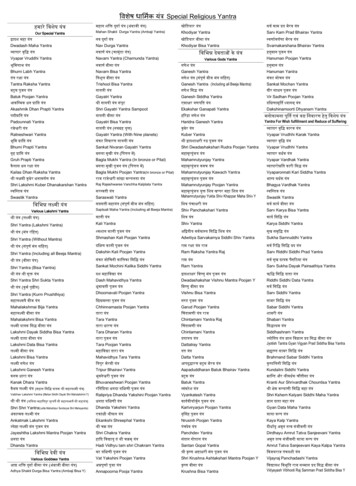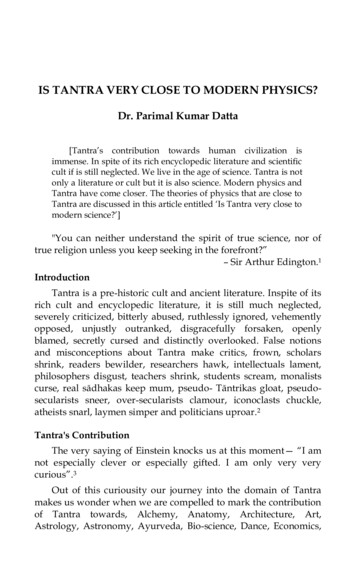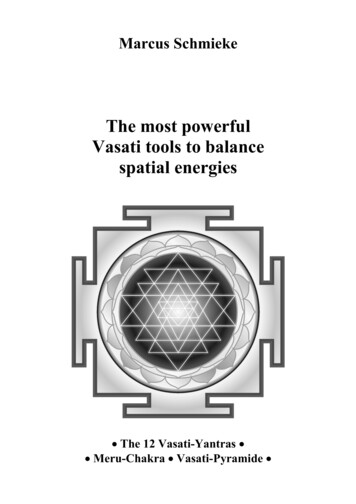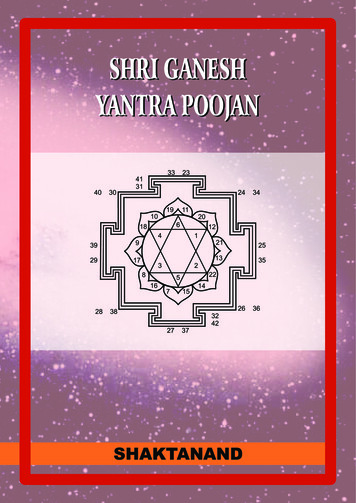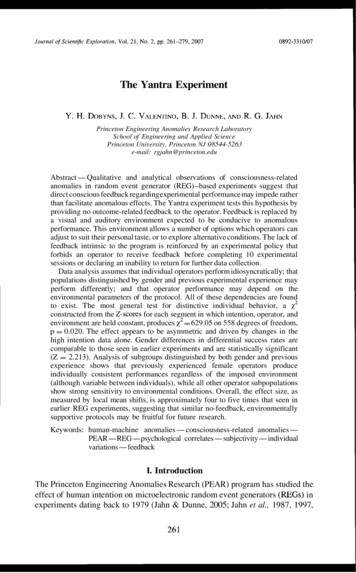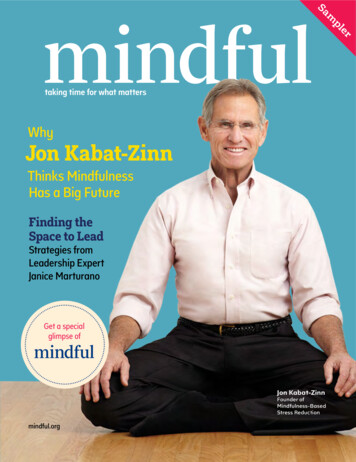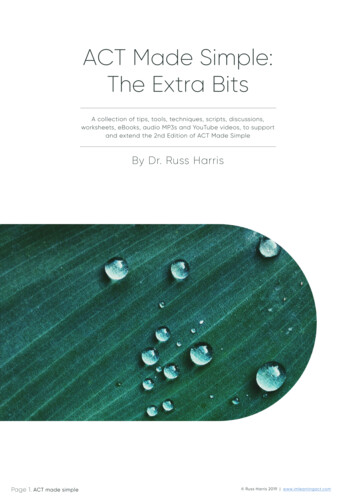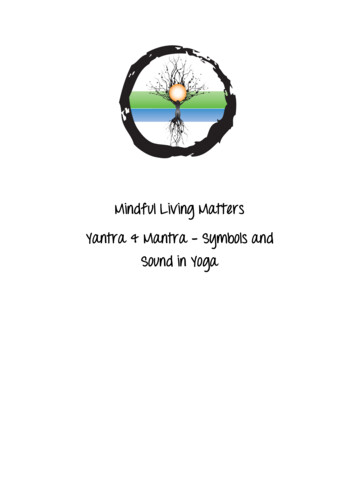
Transcription
Mindful Living MattersYantra & Mantra – Symbols andSound in Yoga
In Hinduism there are three aspects of worship – Yantra, Mantra and Tantra.Yantra uses the physical and visual aspects of ritual. In yoga this could mean the setting up of theyoga space including laying down the yoga mat, burning incense, placing symbols or imaginesaround the yoga room.Tantra uses the feeling aspects of ritual. In its original form Tantra referred to certain bodilypostures and personal mind control techniques. Today there is a misconception that Tantra isachieved through sex. While it is true that ‘tantric’ sex is a form of instant “enlightenment” forsome, in its historic and simplistic pure form Tantra can refer to the concentration one pays whiledoing a yoga posture or performing a mindful act.Mantra uses sound generation to lift energy, create intense feelings, set the mood and awaken thespirit. Chanting a sacred sound can be one word or a set of syllables. Using mantra produces avibration with the body and projects this into the universe.These notes will focus on the aspects of Yantra and Mantra which you can all use to enhance youryoga practice.Mantra and ChantingThere are many different reasons for using mantras orchants some ranging from spiritual, to cultural andpossibly some bordering on religious. However I like touse mantra to focus my thoughts. I find picking a mantraand using each word to direct my breath. In some casesjust singing the words can make me feel psychologicallybetter while other times I actually ponder the meaningbehind it.The use of mantras and chanting is as individual asmeditating itself. Find something that works for you.Explore it for yourself.My favourite mantras & chants: Om mani padme hum (I am a jewel lotus flower)So hum (I am all that)OM (believed to be the Universal sound)Sa – Ta – Na – Ma (Birth – Life – Death – Rebirth)Om Shanti Shanti Shanti (Peace to you, peace to others, peace to the universe)
Om Mani Padme HumOm Mani Padme Hum - means that in dependence on thepractice of a path which is an indivisible union of methodand wisdom, you can transform your impure body, speech,and mind into the pure exalted body, speech, and mind ofa Buddha.Om - symbolize one's impure body, speech and mind, andalso the pure noble body, speech and mind of a BuddhaMani - the jewel, symbolizes factors of method, compassion and love, the altruistic intention tobecome enlightenedPadme - means lotus and symbolizes wisdomHum - means inseparability; symbolizing purity & can be achieved by the unity of method andwisdomLinks of InterestOm Mani Padme Hum – when I was in India I meet the most wonderful Nepalese Man. I actuallybought a traditional Om Mani Padme Hum mandala from him. He also gave me a copy of a BuddhistMonk Mantra. I love using this sound to meditate. By the end I am chanting this out loud. I havefound it on You Tube so you can all enjoy the same sounds.http://youtu.be/bbgHZWwyhcQOm - Chanted 108 times (use with Mala Beads)http://youtu.be/8EhCHVVbtpUOm – think this just sounds awesome and a pretty mandala (of sorts) to look athttp://youtu.be/CQUQmG0OnV4Om – with Binaural sounds (I am just starting to explore these sounds so can explain more as I learnmore). This is a shorter chanting session.http://youtu.be/ApINbGVpYEs
RaMaDaSa – I have included this because I really Like Snatam Kaur. She has a beautiful sound.http://youtu.be/kYivP3gedCoSa-Ta-Na-Ma – this is a beautiful version; you could also try Snatam Kaur’s version on her FeelingGood CDhttp://youtu.be/xASC7Nav0J0
Yantra and MandalasArt work or physical objects can be used as a tool tofocus the mind.A mandala is a circular object or shape that representswholeness or oneness. A Mandala reminds us of thecosmic unified structure of life. Mandalas can be foundeverywhere – from nature (the moon and sun, flowers,spider webs, the shape of our galaxy), to architecture(Mosques, cathedrals, labyrinth designs), to symbolicrepresentations in art (Hindu and Tibetan art) andcultural representation.Centre of the mandala is held at eye height about two feetaway from you.The object is to gaze at your mandala exploring thedifferent parts moving from the outer edge inwards.When you reach the centre, close your eyes and visualisethe mandala. Look for an inner connection betweenyourself and the mandala. Feel the energy travel betweenyourself and the mandala going deep within your innercore.
FocusFocusing techniques include breathing, use of yantras / mandalas and mantras or chants. Otherfocusing tools include mala beads (prayer beads), similar to rosary.Tools such as mala beads and mantras help to keep our mind from wandering.Mala BeadsActs like an anchor for the mind. Moving each malabead with the rhythm of the breath provides a perfectfocus and prevents the mind from being distracted byfleeting thoughts.There are often 108 string of beads in a mala necklace.(Bracelets will often have 27 – another traditionallyauspicious number) A mala bead necklace (andbracelet) will have a master bead (sumeru, guru bead) often used as the starting and end point foryou meditation. In some practices the master bead is never passed over. Therefore if you wish docontinue with your meditation after 1 round, the mala is turned around to proceed again in thereverse direction. In other practices skipping over the master bead is accepted.The master bead is thought to represent the higher consciousness or inner self.Why 108 Beads?Many reasons for their being 108 beads on a mala necklace, some spiritual significance, othersmathematical and even scientific. There are plenty of theories abounding. A couple of myfavourites: Heart Chakra: The chakras are the intersections of energy lines, and there are said to be atotal of 108 energy lines converging to form the heart chakra. One of them, sushumna leadsto the crown chakra, and is said to be the path to Self-realization.Pranayama: If one is able to be so calm in meditation as to have only 108 breaths in a day,enlightenment will come.Pentagon: The angle formed by two adjacent lines in a pentagon equals 108 degreesSanskrit alphabet: There are 54 letters in the Sanskrit alphabet. Each has masculine andfeminine, shiva and shakti. 54 times 2 is 108.First man in space: The first manned space flight lasted 108 minutes, and was on April 12,1961 by Yuri Gagarin, a Soviet cosmonaut.I have also read that to complete a whole cycle of a mala necklace is to finish at 100 but the necklaceholds 108 to allow for 8 errors or distractions. I particularly like this because it reminds me I amhuman and subject to failures at some point in my life however I am still able to proceed withoutpunishment or judgement of those failings.
Yantra & Mantra – Symbols and Sound in Yoga . In Hinduism there are three aspects of worship – Yantra, Mantra and Tantra. Yantra uses the physical and visual aspects of ritual. In yoga this could mean the setting up of the yoga space including laying down t
